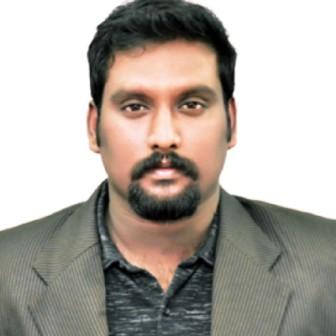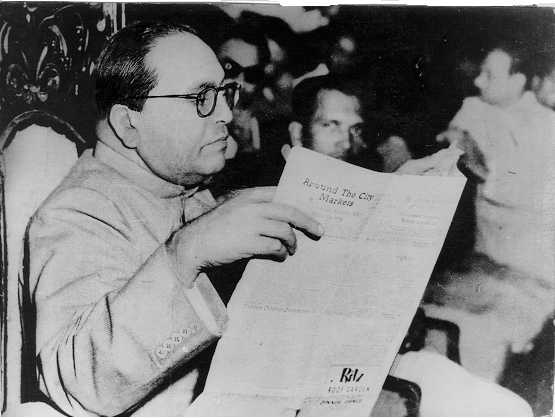Sree Govind Bharatvaraj
Pa. Ranjith’s Kaala makes an Ambedkarite critique of the communists yet calls for their participation in a collective battle against Hindutva.
Keywords: caste; Hindutva; communist; Ranjith; Kaala
Tamil filmmaker Ranjith (well known as Pa. Ranjith) is an Ambedkarite who is influenced by the 1990s Dalit political movements. In his movie Kaala, he makes a criticism of the communists’ understanding of caste and Dalit questions. Yet he stresses the need and importance of communist groups in collaborating with Ambedkarites to fight against present-day Hindu nationalist forces. In the movie, we can understand this by reading the political symbols and by analyzing the characterization of the father-son duo—Kaala and Lenin.
In the film, Lenin is depicted as a staunch communist. However, he works for Manu builders (metaphorical reference to Hindutva), believing that the latter is helping the slum people by building free housing colonies. But Kaala, being an Ambedkarite, clearly understands the notions behind Manu builders. He is aware that the Manu builders are driven by the ideology of Hindutva and came in the garb of neoliberal development. In a conversation between both, Kaala asks Lenin, “If we have to live the slum life, why do we need buildings?” Lenin replies, “So? Show me a place without problems! They have come to construct buildings, not bungalows.” Kaala responds, “They come with money in mind, not people’s welfare. How will they build good houses? When were the rich concerned about the poor?” Lenin says, “Show me one unselfish person. Let me see.” Kaala gets angry and replies, “This is why you shouldn’t do anything. With no understanding of the land and people (Dalits), you read two books and go around muttering about change and revolution. Understand the basics first!”
Kaala stresses on the need for understanding the fundamentals of caste, without which, in a country like India, solving a complex socio-political problem is difficult. In the film, Lenin represents the ineptness of communism in addressing caste and Dalit questions. And Kaala reflects the discontentment of the Ambedkarites toward the communists. It is a fact that Dalit parties had this contestation with communist organizations when they neglected caste concerns. And it is arguably only after the 1990s mobilization of Dalit organizations and the popularity of the Dalit movement that communist groups took caste concerns seriously. This situation is true even in Tamil Nadu, where the Communist Party of India (Marxist) looked at caste as equally problematic as class, only after the emergence of Viduthalai Chiruthaigal Katchi (VCK—Dalit Panthers Party) in the state.
It is significant to understand that the film criticizes the communists for their negligence regarding caste concerns. However, by no means it rejects or disregards the participation of communists in a collective social-justice movement. The same can be understood in another scene in the movie, where Kaala defends Lenin, saying that “we both might have a million differences. But I do not doubt the respect and commitment he has for this land. ”We need to understand that this is not a cinematic conversation between a father and son; rather, it is a discourse between Ambedkarism and communism on the screen. Director Ranjith insists the communist groups to understand caste issues in a better manner so that both social justice forces can fight against the dominant Hindutva politics. Ranjith understands that present-day Hindutva uses the notions of development to construct a Hindu cultural nation bound by Manu-Smriti (an authoritative scripture that contributes to the caste system in the Hindu society). Political analysts, Teltumbde calls this as neoliberal Hindutva (see Teltumbde 2018). To fight against such dominant forces, Ranjith demands the communist groups to learn caste problems better and deploy a collective battle.
Ranjith describes this in the film through effective political symbolism. In the movie, we can observe images of the anti-caste thinker “Iyothee Thass,” along with “Karl Marx” and “Vladimir Lenin.” Iyothee Thass was a nineteenth-century anti-caste intellectual from Tamil Nadu. He strongly castigated Brahminism and Manu-Smriti and created an anti-caste movement in Tamil Nadu. Iyothee Thass saw Buddhism as an emancipatory religion. He said that Dalits were once Buddhist, and that is the reason the Brahminical system has oppressed them to a greater extent. Interestingly, Ambedkar’s thoughts correlate with notions of Buddhism similar to those of Iyothee Thass. And Iyothee Thass further served as an inspiration for Ambedkar towards his path in radical Buddhism (Aloysius 1998). The link between Iyothee Thass and Ambedkar thus connects with the idea of Buddhism. Further, Ambedkar’s most significant work, written during his final days, was “Buddha or Karl Marx.” This work finds similarities between Buddha and Marx and tries to create a discourse on the most suitable philosophy amongst both for achieving equality, fraternity and liberty. To construct a counter-politics against Hindutva, an inherently unequal socio-political philosophy, director Ranjith presents the need and significance of Buddha and Marx in the film.
Through symbolically displaying the images of Iyothee Thass along with Marx and Lenin, Ranjith intends to communicate two political aspects: First, the need and importance of creating a discourse on Ambedkar’s work, “Buddha or Karl Marx.” Second, he insists the communist groups in Tamil Nadu read Iyothee Thass to understand the significance of Buddhism in handling caste problems. By placing Iyothee Thass along with the communist philosophers, Ranjith is therefore shifting the discourse of Buddhism from Ambedkarites to communist groups—to create a better socio-political understanding of caste and class.
In the real political scenario, the scope for such understanding between communism and Ambedkarism is discernible to some extent. The National Secretary of the Communist Party of India, D. Raja, says,
“Earlier, all the Dalit colonies in northern Tamil Nadu had photos of Buddha and Ambedkar. During my early years as a school student, I came to know about Buddha and Ambedkar through their birth anniversary celebrations. Later, I was introduced to the principles of Karl Marx. Then, in my college days, I came to know about IyotheeThass, who organized the first conference on Buddha’s teaching in Tamil Nadu. Thus, I am shaped by the thoughts of both communism and Buddhism. Buddha does not care about the existence of God or the soul. His only problem was human beings. He believed that, through his teaching, humans could walk on a good path. The principles of both Buddha and Karl Marx are more or less equal. Ambedkar was the first person who tried to build a link between Buddha and Marx”
(The New Indian Express 2013).
In a struggle towards an anti-caste egalitarian society and in the fight against dominant Hindutva politics, Ranjith stresses the importance of collaboration between the communist and the Ambedkarite. The same can be witnessed at the climax of the movie. In the film, the Hindutva villain will be finally lynched by the working-class mob in the streets of the slum, which is splattered by the colors blue (Ambedkarism) and red (communism).
~
References
Aloysius, G (1998): Religion as Emancipatory Identity: A Buddhist Movement among the Tamils under Colonialism, New Delhi: New Age International (P) Limited.
Teltumbde, Anand (2018): Republic of Caste: Thinking Equality in the Time of Neoliberal Hindutva, New Delhi
The New Indian Express (2013): “Buddhist philosophies are a way of life,” 04 April, https://www.newindianexpress.com/cities/chennai/2013/Apr/04/buddhist-philosophies-are-a-way-of-life-464755.html
~~~
Dr. Sree Govind Bharatvaraj is working as a guest faculty member at the Central University of Tamil Nadu, Thiruvarur. He is an ardent researcher whose work broadly focuses on anti-caste studies, social movements, and caste and Dalit representation in popular culture. He currently works on anti-caste cinema trends, both in Tamil films and in Indian cinema. He has published in esteemed journals like South Asian Popular Culture and South Asian Review.









